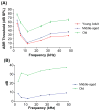Auditory sensitivity and the outer hair cell system in the CBA mouse model of age-related hearing loss
- PMID: 21866215
- PMCID: PMC3159169
- DOI: 10.2147/OAAP.S7202
Auditory sensitivity and the outer hair cell system in the CBA mouse model of age-related hearing loss
Abstract
Age-related hearing loss is a highly prevalent sensory disorder, from both the clinical and animal model perspectives. Understanding of the neurophysiologic, structural, and molecular biologic bases of age-related hearing loss will facilitate development of biomedical therapeutic interventions to prevent, slow, or reverse its progression. Thus, increased understanding of relationships between aging of the cochlear (auditory portion of the inner ear) hair cell system and decline in overall hearing ability is necessary. The goal of the present investigation was to test the hypothesis that there would be correlations between physiologic measures of outer hair cell function (otoacoustic emission levels) and hearing sensitivity (auditory brainstem response thresholds), starting in middle age. For the CBA mouse, a useful animal model of age-related hearing loss, it was found that correlations between these two hearing measures occurred only for high sound frequencies in middle age. However, in old age, a correlation was observed across the entire mouse range of hearing. These findings have implications for improved early detection of progression of age-related hearing loss in middle-aged mammals, including mice and humans, and distinguishing peripheral etiologies from central auditory system decline.
Conflict of interest statement
The authors report no conflicts of interest in this work.
Figures





References
Grants and funding
LinkOut - more resources
Full Text Sources
